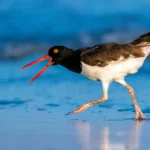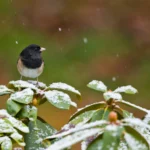Although seldom seen by the casual birdwatcher, woodpecker tongues are a big part of what makes these birds unique. In combination with powerful chisel-like beaks, long, specialized tongues help woodpeckers access food other birds can’t. But that’s not the only thing that makes these organs so special. Tongues help make woodpeckers’ high-impact pecking possible in a surprising and ingenious way.
If you’re curious to learn more, you’re in the right place. Below, we’ve answered some of the most-asked questions about woodpeckers’ fine-tuned tongues.
Do woodpeckers have tongues?
Yes! Like all birds, woodpeckers have tongues tucked inside those large beaks. Different woodpecker species use their tongues in different ways, depending on exactly what and how they eat. They all tend to have surprisingly long tongues, though, which help them reach deep into crevices in search of beetle larvae (grubs) and other prized morsels. Storing an exceptionally long tongue inside a relatively small head is a challenge, and woodpeckers have some unique anatomical features to make this happen.
How does a woodpecker's tongue work?
In both humans and birds, the tongue is supported by a bone called the hyoid. Your hyoid bone is a horseshoe-shaped structure under your jaw that gives the muscles in your tongue and the floor of your mouth something to attach to. It helps you breathe, swallow, and speak.
A woodpecker’s hyoid bone, however, is vastly different. The center of the woodpecker’s muscle-wrapped hyoid is in the nostrils, in the bird’s upper beak. It splits into a V between the eyes, and its two arms wrap completely around the woodpecker’s skull, passing over the top of it and around the back before meeting up again at the base of the lower beak.
When the muscles surrounding the hyoid contract, the tongue projects forward, through the length of the beak and out its end. But when those muscles relax, the woodpecker’s tongue retracts along the length of the hyoid. Yep — a woodpecker’s tongue is so long that it needs to be coiled around the back of its owner’s skull.
So how long is a woodpecker's tongue?
The total length of a woodpecker tongue can be up to a third of the bird’s total body length, although the exact proportions vary from species to species. This includes both the part that sticks out past the end of the beak, and the part that stays anchored in the head. If our tongues were the same proportion, they would be around two feet long!
Occasionally those long tongues can even get woodpeckers into trouble. Scientists who catch woodpeckers for study sometimes have to carefully detangle the birds’ tongues from their nets.
Which woodpecker has the longest tongue?
In North America, the tongue-length champion is the Northern Flicker, with a tongue that can stick out two inches past the tip of this bird’s bill.
As for which species holds the world record — well, we’re not sure anyone’s ever measured the tongue length of all 240 or so woodpecker species, and a definitive answer has yet to be given.
What does a woodpecker's tongue look like?
It depends! Although they all share the same basic anatomy, different woodpecker species have different tongues that are specialized for snagging various types of food.
The Northern Flicker’s extra-long tongue, for example, is sticky and relatively smooth, perfect for snaking deep into anthills to capture and retrieve ants. Pileated Woodpecker tongues, on the other hand, are relatively short, with barbed tips for extracting prey from bark crevices — maybe not what you’d expect from such a large woodpecker.
Sapsuckers, which mostly consume tree sap, may have the most interesting apparatus of all. Their brush-tipped tongues can lap up oozing sap by capillary action. Across a small enough diameter, the surface tension between water molecules and the attraction between these molecules and surrounding surfaces can actually be stronger than gravity. This is what causes water to “climb” the fibers of a paper towel, and it also helps sapsuckers wick tree sap up their brushy tongues and into their mouths. Hummingbirds have a similar adaptation for drinking nectar out of flowers.
Does a woodpecker's tongue protect its brain?
Yes. Having its tongue wrapped around the back of its brain doesn’t just give a woodpecker somewhere to store a long appendage; it also helps protect the bird’s brain from injury during high-speed pecking.
When the muscles that surround the woodpecker hyoid bone contract, they don’t just cause the woodpecker to stick out its tongue. That tensing-up action also helps hold the skull and spine snugly in place as the bird’s beak collides with a tree, just like a seat belt keeps you from flying forward if someone slams on the brakes.
How do we know all this? In 2011, a group of Chinese scientists used special high-speed cameras to take slow-motion 3D videos of a pecking Great Spotted Woodpecker. They also used sensors to measure the bird’s pecking force and examined the structures in its skull and beak with CT scanners and scanning electron microscopes.
Tongues aren’t the only part of a woodpecker’s cranial anatomy that helps to keep the bird’s brain safe. There are also extra plates of spongy bone in the front and back of the skull. Sandwiched between layers of denser, more compact bone, these softer bones help absorb and distribute the shock each time a woodpecker strikes a tree.
How can I help woodpeckers?
We all can do our part to protect birds.
American Bird Conservancy and our Joint Venture partners have improved conservation management on 6.4 million acres of U.S. bird habitat — an area larger than the state of Maryland — over the last ten years. This is a monumental undertaking, requiring the support of many, and you can help by making a gift today.
Policies enacted by Congress and federal agencies, such as the U.S. Fish and Wildlife Service, have a huge impact on America’s birds. You can help shape these rules for the better by telling lawmakers to prioritize birds, bird habitat, and bird-friendly measures. To get started, visit ABC’s Action Center.
Finally, don’t overlook the impact you can have at home. Living a bird-friendly life can have an immediate impact on the birds around you. Doing so can be as easy as adding native plants to your garden, avoiding pesticides, and keeping cats indoors. To learn more, visit our Bird-Friendly Life page.










